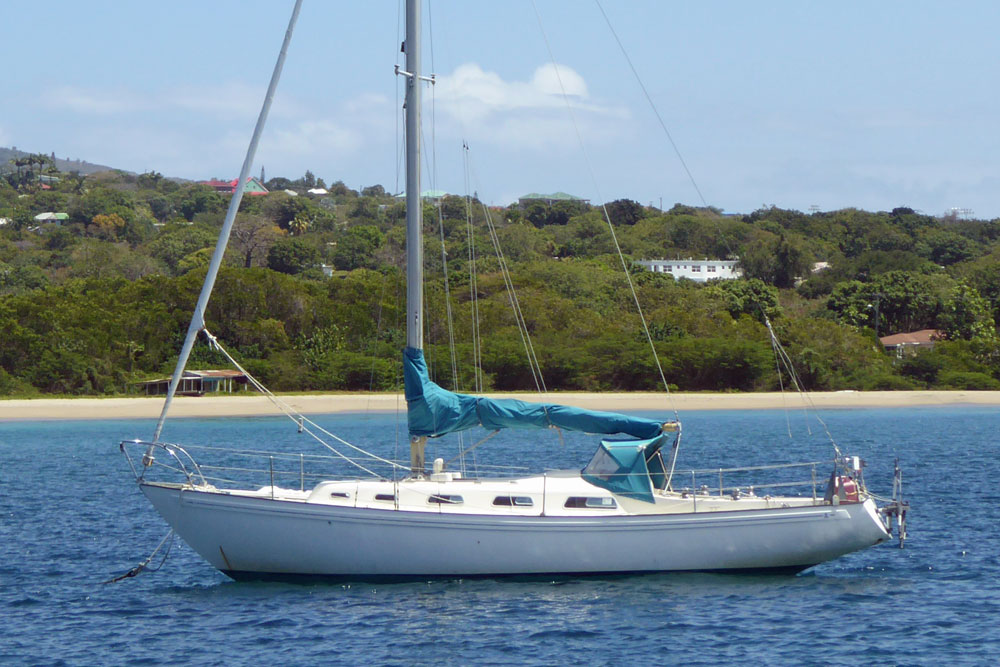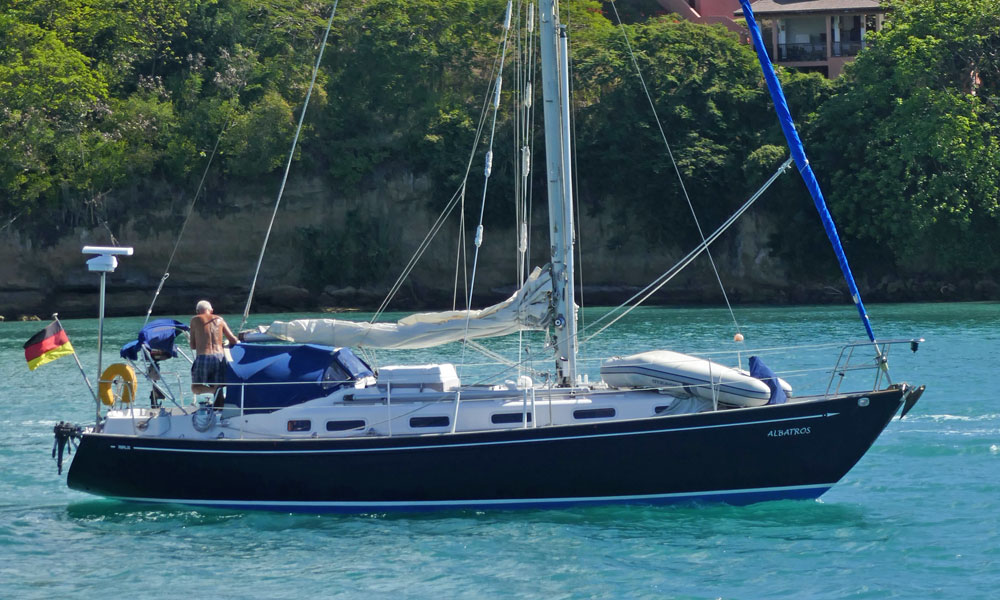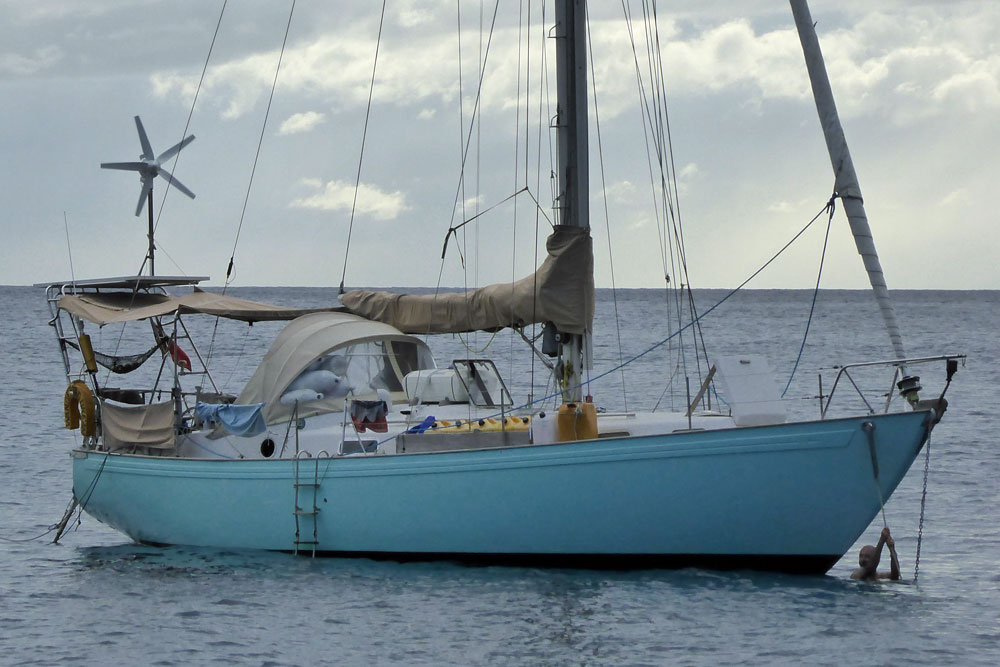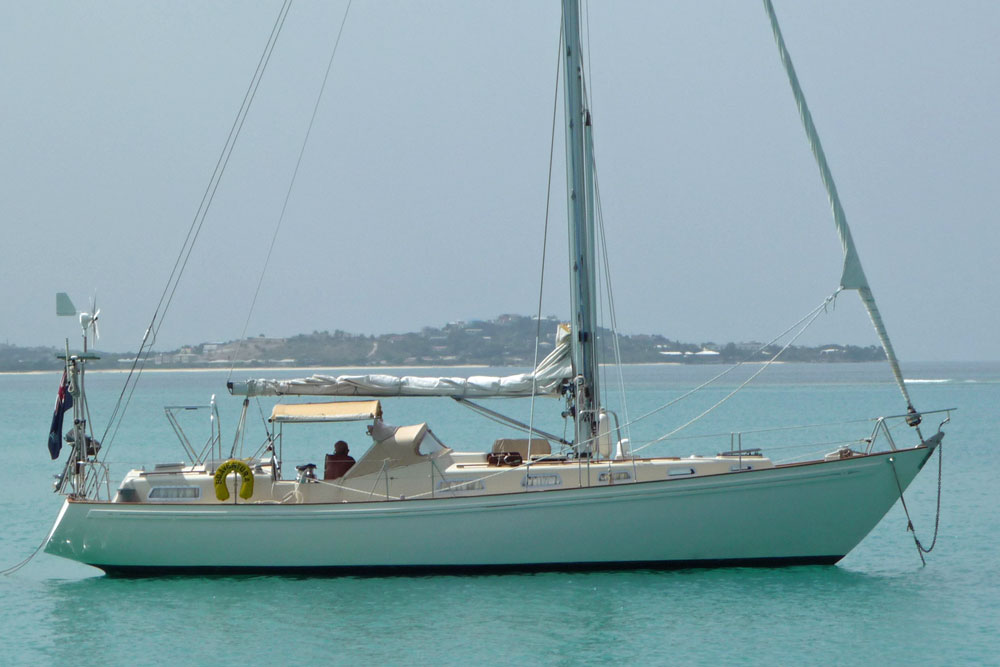- Home
- Rival sailboats
A Rival to None: The Legacy of a Legendary British Yacht Builder
In a Nutshell...
Rival Yachts, founded by the talented designer Peter Brett in the late 1960s, is a British boatbuilder renowned for creating "bulletproof" bluewater cruisers. Their vessels, including the popular Rival 34, Rival 36, and Rival 38, are celebrated for their exceptional seaworthiness, strong GRP construction, and a sea-kindly motion that makes them ideal for long-distance cruising.
While not known for winning races or outright speed, Rival yachts are prized for their structural integrity, safety, and comfort in heavy weather, with a design philosophy that prioritizes offshore capability and owner-friendly interiors. They have a strong reputation and hold their value well on the second-hand market, with a loyal community of owners who appreciate their classic, no-nonsense approach to sailing.
 The Rival 34
The Rival 34Table of Contents
The Birth of a Bluewater Legend: Company History & Philosophy
The story of Rival Yachts begins with Peter Brett, a designer with a passion for offshore sailing and a keen eye for what makes a yacht truly seaworthy. In the mid-1960s, a time when many boats were still being built from wood, Brett saw the potential of fiberglass (GRP) as a material for durable, long-distance cruising yachts. He developed his first design, the Rival 31, and in 1967, teamed up with Eric White of Marine Construction (Woolston) Ltd. to bring it to life. This collaboration marked the beginning of a brand that would become synonymous with robust, ocean-crossing vessels.
Brett's design philosophy was simple yet profound: build boats that are safe, comfortable, and capable of handling the most challenging conditions the ocean can throw at them. His designs were a direct reflection of his own experience and a deep understanding of what sailors need to feel secure at sea. He was not chasing outright speed or trendy design features but focused on creating yachts with excellent stability, a predictable motion, and a strong hull layup.
This pragmatic approach earned Rival a reputation for "bulletproof" construction, a moniker still used by owners today. The brand's success was cemented when a Rival 34 named Wild Rival, sailed by Peter Brett himself, won the OSTAR (Observer Single-handed Trans-Atlantic Race) on handicap in 1976, proving the boat's offshore pedigree in a particularly windy race.
 The Rival 36
The Rival 36What makes a Rival yacht's construction so durable?
Rival Yachts are distinguished by their robust construction methods, which set them apart from many of their contemporaries. They pioneered the use of GRP (glass-reinforced plastic) for cruising yachts, employing a solid, hand-laid layup for the hull. This method, which involves layers of fiberglass mat and woven roving saturated with resin, results in a strong, monolithic hull that is resistant to osmosis and is known to be incredibly tough.
The keels are often a long fin with an encapsulated ballast, integral to the hull structure, which is a signature design feature that enhances stability and provides a strong, reliable attachment point. Decks were also typically GRP with a molded-in non-skid surface, and the hull-to-deck joint was robustly constructed to ensure structural integrity. This commitment to traditional, heavy-duty construction is a key reason for the brand's enduring reputation.
 A Rival 38
A Rival 38Design Evolution & Key Models
Over the years, the Rival brand evolved, but its core design principles remained constant. Peter Brett's designs were characterized by their deep, canoe-like bodies, long overhangs, and a high ballast-to-displacement ratio, all contributing to their exceptional seakeeping abilities. While the designs were classic, they were not static; Brett continually refined his work based on feedback and his own sailing experiences.
The Rival 31 & 32: The Foundation
The original Rival 31, launched in 1968, laid the groundwork for the entire brand. It was a well-balanced boat, and a slight modification to the rudder stock in later models further improved its handling. This design led to the Rival 32, a hugely successful evolution with a short counter. More than 200 of the Rival 32s were built, establishing the brand's foothold in the market for serious cruising yachts.
The Rival 34: The OSTAR Winner
The Rival 34, launched in 1972, is arguably the most iconic of the Rival models. Building on the success of the 32, it featured a fuller afterbody and longer overhangs, which contributed to even greater stability and seaworthiness. The deep keel version of the 34 is particularly prized for its upwind performance. The model's victory in the 1976 OSTAR race solidified its reputation as a formidable offshore cruiser.
The Rival 36: A Refined Classic
Following the triumph of the Rival 34, Peter Brett's final Rival design was the Rival 36, launched in 1980. With 78 hulls built, it was a successful model designed to fill the gap between the celebrated 34 and the larger 38. The Rival 36 refined the brand's proven design philosophy, offering excellent seaworthiness and a solid build quality that was certified to Lloyds 100A1 standards.
The 36 was notable for its design flexibility, a feature that catered to a wider range of sailing needs. It was offered in three different keel configurations: a deep-draft fin keel, a shoal-draft Scheel keel, and a centerboard version. This choice allowed owners to optimize their boat for either deep-water performance or shallow-water cruising, a testament to the brand's responsiveness to the market.
The Rival 38 & 41: Room for Adventure
The Rival 38, launched in 1977, was a significant step up in size and comfort. It retained the classic Rival lines but with fuller ends, which allowed for the option of an aft cabin. The 38, available in both aft and center cockpit versions, is highly regarded as a comfortable liveaboard sailboat and a capable bluewater cruiser.
The Rival 41, also available as an aft or center cockpit model, was designed for long-range cruising and is a sought-after vessel for serious voyagers. The center cockpit version, in particular, offers a secure and dry place to stand watch in heavy weather and a spacious aft cabin below.
 A Rival 41CC (Centre Cockpit)
A Rival 41CC (Centre Cockpit)Performance & Onboard Experience
Rival yachts are not known for being sprightly or fast in light airs. They are heavy displacement boats, designed to carry cruising gear without a significant impact on their waterline. This weight, combined with their deep canoe body and fin keel, provides an incredibly comfortable motion in a seaway. They are steady, stable, and have an excellent righting capability, making them exceptionally safe in rough conditions.
They are at their best when the wind pipes up, carrying their canvas and pointing well upwind when other boats are forced to shorten sail. The trade-off for this seaworthiness is a slower pace in calm weather and a need for a good breeze to get them moving.
What is life like onboard a Rival sailboat?
Life onboard a Rival is all about practicality and comfort at sea. The interiors are traditionally styled, often with well-crafted teak joinery, and designed with a cruising sailor in mind. This means secure handholds are everywhere, the galleys are functional for use on a heeled boat, and the layouts prioritize storage and safety over open-plan living.
Headroom is generally good, and while the cabins might not feel as expansive as a modern production boat, they are cozy and well-thought-out. Many Rival owners appreciate this focus on function over form, which makes them excellent for liveaboard or long-term cruising.
Buying a Rival: What to Look For & Known Issues
When considering a used Rival yacht, you are buying into a legacy of solid, well-built boats. Their structural integrity is a significant selling point, and with proper maintenance, they can last for many decades. However, as with any classic boat, there are points to consider.
- Rigging: The standing and running rigging on older boats will likely require replacement if not already updated.
- Engine: The original engines (often Perkins or Bukh) may have been replaced or require significant servicing. Check the engine's history and condition carefully.
- Deck & Deck Fittings: While the GRP decks are solid, check for soft spots, especially around deck hardware, as water ingress can be an issue over time if fittings have not been properly re-bedded.
- Tiller vs. Wheel: Many of the smaller models, such as the Rival 34, came with a tiller. Some owners have converted to wheel steering, but many purists appreciate the direct feel and responsiveness of a tiller. This is a matter of personal preference but is worth noting.
Rival's story in the 1980s became more complex, with the company becoming part of a series of mergers and takeovers involving other notable builders like Bowman, Starlight, and Rustler. This period of change can make the lineage of some later models a little less straightforward, but the core design principles largely remained.
By Dick McCary, Yachtmaster Offshore (RYA) & member of the Yachting Journalists Association (YJA)
Sources Used
- Rival Owners Association. "History of the Rival Yachts." https://rivalowners.org.uk/history-introduction/history/
Recent Articles
-
Modern Boat Electronics and the Latest Marine Instruments
Dec 20, 25 05:27 PM
Should sailboat instruments be linked to the latest boat electronics as a fully integrated system, or is it best to leave them as independent units? -
Hans Christian 43: Classic Bluewater Cruiser & Liveaboard Sailboat
Dec 10, 25 04:37 AM
Explore the Hans Christian 43: a legendary heavy-displacement, long-keel sailboat. Read our in-depth review of its specs, design ratios, and suitability for offshore cruising and living aboard. -
Planning Your Sailboat Liveaboard Lifestyle: An Ocean Sailor's Guide
Dec 06, 25 05:18 AM
Seasoned sailors share their methodical risk analysis for planning a secure Sailboat Liveaboard Lifestyle, covering financial, property, and relationship risks.












